
Apollo 16 was the tenth crewed mission in the United States Apollo space program, administered by NASA, and the fifth and penultimate to land on the Moon. It was the second of Apollo's "J missions", with an extended stay on the lunar surface, a focus on science, and the use of the Lunar Roving Vehicle (LRV). The landing and exploration were in the Descartes Highlands, a site chosen because some scientists expected it to be an area formed by volcanic action, though this proved not to be the case.
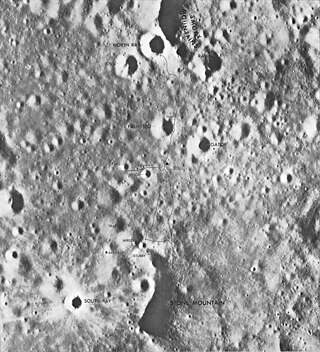
The Descartes Highlands is an area of lunar highlands located on the near side that served as the landing site of the American Apollo 16 mission in early 1972. The Descartes Highlands is located in the area surrounding Descartes crater, after which the feature received its name.
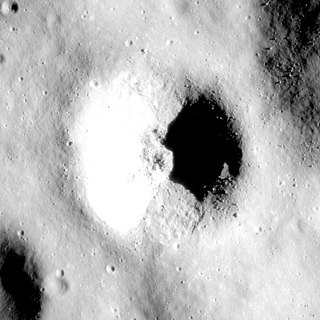
North Ray crater is a small crater in the Descartes Highlands of the Moon visited by the astronauts of Apollo 16. The name of the crater was formally adopted by the IAU in 1973. It is the largest crater sampled by astronauts during the Apollo program.

South Ray crater is a small crater in the Descartes Highlands of the Moon photographed from the lunar surface by the astronauts of Apollo 16. The name of the crater was formally adopted by the IAU in 1973.

Palmetto crater is a small crater in the Descartes Highlands of the Moon visited by the astronauts of Apollo 16. The name of the crater was formally adopted by the IAU in 1973.
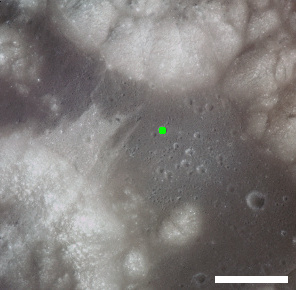
Camelot is a feature on Earth's Moon, a crater in Taurus-Littrow valley. Astronauts Eugene Cernan and Harrison Schmitt visited it in 1972, on the Apollo 17 mission, during EVA 2. Geology Station 5 was along the south rim of Camelot.

Victory is a feature on Earth's Moon, a crater in Taurus–Littrow valley. Astronauts Eugene Cernan and Harrison Schmitt visited it in 1972, on the Apollo 17 mission, during EVA 2. The astronauts stopped at the south rim of Victory on their way back to the Lunar Module from Shorty crater.
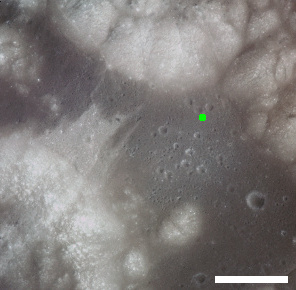
Van Serg is a feature on Earth's Moon, a crater in Taurus–Littrow valley. Astronauts Eugene Cernan and Harrison Schmitt visited it in 1972, on the Apollo 17 mission, during EVA 3. Van Serg was designated Geology Station 9.
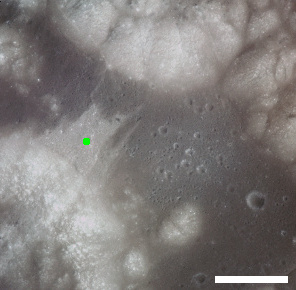
Lara is a feature on Earth's Moon, a crater in Taurus-Littrow valley. Astronauts Eugene Cernan and Harrison Schmitt visited it in 1972, on the Apollo 17 mission, during EVA 2. Geology Station 3 of the mission is located on the northeast rim of Lara.
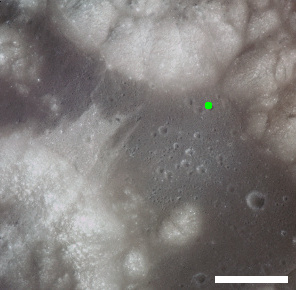
Cochise is a feature on Earth's Moon, a crater in Taurus-Littrow valley. Astronauts Eugene Cernan and Harrison Schmitt landed southwest of it in 1972, on the Apollo 17 mission. They drove along its rim in the rover during EVA 3, but did not stop.

Trident is a feature on Earth's Moon, a crater in Taurus-Littrow valley. Astronauts Eugene Cernan and Harrison Schmitt landed about 300 m north of its rim in 1972, on the Apollo 17 mission. They drove along the east rim of Trident during EVA 1 of the mission, in their rover.

Spur is a feature on Earth's Moon, a crater in the Hadley–Apennine region. Astronauts David Scott and James Irwin visited it in 1971, on the Apollo 15 mission, during EVA 2. Spur was designated Geology Station 7.

Dune is a feature on Earth's Moon, a crater in the Hadley–Apennine region. Astronauts David Scott and James Irwin visited the south rim of it in 1971, on the Apollo 15 mission, during EVA 2. The south rim of Dune was designated Geology Station 4 of the mission.

Flag crater is a small crater in the Descartes Highlands of the Moon visited by the astronauts of Apollo 16. The name of the crater was formally adopted by the IAU in 1973. Geology Station 1 is adjacent to Flag, at the much smaller Plum crater.
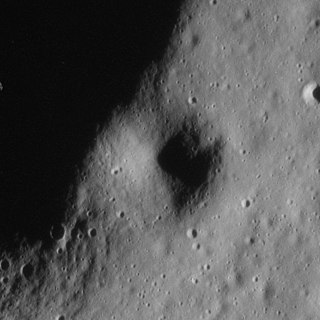
Elbow is a feature on Earth's Moon, a crater in the Hadley–Apennine region. Astronauts David Scott and James Irwin visited the east rim of it in 1971, on the Apollo 15 mission, during EVA 1. The east rim of Elbow was designated Geology Station 1 of the mission. Geology Station 2 was to the southwest of the crater, up the slope of Mons Hadley Delta.
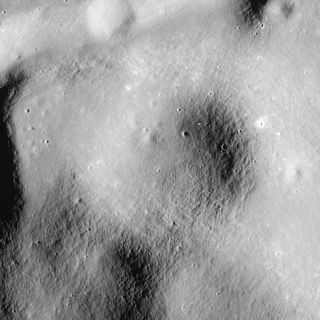
St. George is a feature on Earth's Moon, a crater in the Hadley–Apennine region. Astronauts David Scott and James Irwin drove their rover onto what was suspected to be its ejecta blanket in 1971, on the Apollo 15 mission, during EVA 1. They collected samples to the northeast of the crater, at Geology Station 2 of the mission.

Cinco is a small crater in the Descartes Highlands of the Moon visited by the astronauts of Apollo 16. The crater is one of a group of five (hence the name, Spanish for five) craters that were collectively called the Cinco craters during the Apollo 16 mission. The craters were designated a, b, c, d, and e, and the largest (a) was officially named Cinco after the mission in 1973 by the IAU.

Surveyor crater is a small crater in Oceanus Procellarum on the Moon. The name of the crater was formally adopted by the IAU in 1973.

Head crater is a small crater in Oceanus Procellarum on the Moon. The name of the crater was formally adopted by the IAU in 1973.

Cone crater is a small crater in the Fra Mauro highlands, north of Fra Mauro crater, on the Moon. The name of the crater was formally adopted by the IAU in 1973.
































